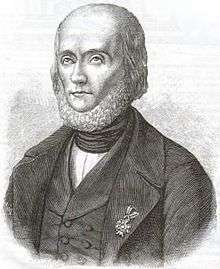Philippe de Girard

Philippe Henri de Girard (February 1, 1775 – August 26, 1845[1][2]) was a French engineer and inventor of the first flax spinning frame in 1810, as well as the name-sake for the town of Żyrardów in Poland. He was also the uncredited inventor of food preservation using tin cans.[3][4]
Biography
Girard was born in the village of Lourmarin in the département of Vaucluse, France, to a wealthy aristocratic family. As a child he was sent by his parents to some of the most notable French schools of the era. However, in the effect of the French Revolution, his family was forced to flee France and young Philippe had to abandon his studies in order to help his family earn money for living.
In May 1810 Napoleon I tried to stop English cotton fabrics entering the continent of Europe and offered a reward of one million francs to any inventor who could devise the best machinery for the spinning of flax yarn. After only a short period Philippe de Girard took out a French patent for important inventions for both dry and wet methods of spinning flax. He was not awarded the prize money and failed to gain the recognition he felt was deserved. He had been counting on the prize money to pay the expenses of his invention, and he got into serious financial difficulties.[2] So he accepted, when in 1815 he was invited by the Austrian government to establish a spinning mill in Hirtenberg near Vienna, which employed his spinning frames. However, it failed to prove a commercial success.
In 1817 Girard returned to France with a prototype ready, but the internal situation of France after the fall of Napoleon Bonaparte prevented the new French authorities from payment of the debts and eventually Girard sold his patent to England. His inventions were patented in England in 1814, by Horace Hall (possibly a pseudonym). It would not have been easy for a French man to introduce a new development into England at this point in history. It never really caught on.
In the British Isles James Kay has been credited with this invention. Although, on December 2, 1826, shortly after Kay’s patent was awarded, Girard seems to have been prompted to write to the editor of The Manchester Guardian complaining about this and pointing out he had been the inventor. The fact that Horace Hall made no complaint might suggest this name being a pseudonym.
Several years afterwards the situation in France improved and Girard started the first modern textile factory in Lille. Initially the business was a failure and Girard almost went bankrupt.
In 1825 he was hired by the government of the Kingdom of Poland to develop the Polish textile industry. He became the expert of the Polish government, as well as the Bank of Poland. Because of financial support of the latter, in 1831 he organised the first major factory of his project in Marymont near Warsaw. Two years later he moved with his business to the village of Ruda Guzowska, where the factory had better prospects. Soon it became a great success and brought fame and prosperity both to the settlement and to Girard. In honour of Girard, Ruda Guzowska was renamed to Żyrardów, a toponym derived of the polonised spelling of Girard's name.
In 1844 Girard returned to France, where he planned to open more factories. However, he died the following year. Apart from the town of Żyrardów (currently one of the biggest satellite towns of Warsaw), Girard became a name-sake for a street and a college in 18th arrondissement of Paris and two lycea in Żyrardów and Avignon.
He died in Paris.[1] After his death, his work was recognised and his descendants were rewarded with a small pension by the French Emperor.
Other projects
In 1806 he exhibited an improvement in lamps, and in the same year made some improvement in the steam engine, producing a rotary motion without a walking beam.[1] In 1818 he built a steamer to run on the Danube.[2]
References
- 1 2 3
 Ripley, George; Dana, Charles A., eds. (1879). "Girard, Philippe de". The American Cyclopædia.
Ripley, George; Dana, Charles A., eds. (1879). "Girard, Philippe de". The American Cyclopædia.
- 1 2 3
 Chisholm, Hugh, ed. (1911). "Girard, Philippe Henri de". Encyclopædia Britannica (11th ed.). Cambridge University Press.
Chisholm, Hugh, ed. (1911). "Girard, Philippe Henri de". Encyclopædia Britannica (11th ed.). Cambridge University Press. - ↑ "Can Maker FAQ". Retrieved 2011-10-18.
- ↑ Gordon L. Robertson (2006). Food packaging. CRC Press. p. 123. ISBN 0-8493-3775-5.